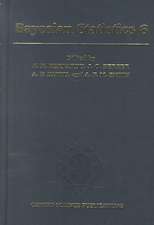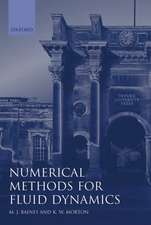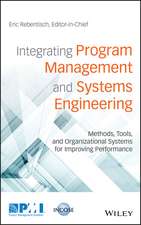Physical Fluid Dynamics: The Modern University in Physics Series
Autor D. J. Trittonen Limba Engleză Paperback – 1977
| Toate formatele și edițiile | Preț | Express |
|---|---|---|
| Paperback (2) | 443.48 lei 31-37 zile | |
| OUP OXFORD – sep 1988 | 443.48 lei 31-37 zile | |
| SPRINGER NETHERLANDS – 1977 | 700.10 lei 6-8 săpt. |
Preț: 700.10 lei
Preț vechi: 823.64 lei
-15% Nou
Puncte Express: 1050
Preț estimativ în valută:
134.01€ • 145.61$ • 112.64£
134.01€ • 145.61$ • 112.64£
Carte tipărită la comandă
Livrare economică 21 aprilie-05 mai
Preluare comenzi: 021 569.72.76
Specificații
ISBN-13: 9780442301323
ISBN-10: 0442301324
Pagini: 362
Ilustrații: XVI, 362 p. 66 illus.
Dimensiuni: 152 x 229 x 20 mm
Greutate: 0.51 kg
Editura: SPRINGER NETHERLANDS
Colecția Springer
Seria The Modern University in Physics Series
Locul publicării:Dordrecht, Netherlands
ISBN-10: 0442301324
Pagini: 362
Ilustrații: XVI, 362 p. 66 illus.
Dimensiuni: 152 x 229 x 20 mm
Greutate: 0.51 kg
Editura: SPRINGER NETHERLANDS
Colecția Springer
Seria The Modern University in Physics Series
Locul publicării:Dordrecht, Netherlands
Public țintă
ResearchCuprins
1. Introduction.- 1.1 Preamble.- 1.2 Scope of book.- 1.3 Notation and definitions.- 2. Pipe and Channel Flow.- 2.1 Introduction.- 2.2 Laminar flow theory: channel.- 2.3 Laminar flow theory: pipe.- 2.4 The Reynolds number.- 2.5 The entry length.- 2.6 Transition to turbulent flow.- 2.7 Relationship between flow rate and pressure gradient.- 3. Flow Past a Circular Cylinder.- 3.1 Introduction.- 3.2 The Reynolds number.- 3.3 Flow patterns.- 3.4 Drag.- 4. Convection in Horizontal Layers.- 4.1 The configuration.- 4.2 Onset of motion.- 4.3 Flow regimes.- 5. Equations of Motion.- 5.1 Introduction.- 5.2 Fluid particles and continuum mechanics.- 5.3 Eulerian and Langrangian co-ordinates.- 5.4 Continuity equation.- 5.5 The substantive derivative.- 5.6 The Navier—Stokes equation.- 5.7 Boundary conditions.- 5.8 Condition for incompressibility.- Appendix: Derivation of viscous term of dynamical equation.- 6. Further Basic Ideas.- 6.1 Streamlines, streamtubes, particle paths and streaklines.- 6.2 Computations for flow past a circular cylinder.- 6.3 The stream function.- 6.4 Vorticity.- 6.5 Vorticity equation.- 6.6 Circulation.- 7. Dynamical Similarity.- 7.1 Introduction.- 7.2 Condition for dynamical similarity: Reynolds number.- 7.3 Dependent quantities.- 7.4 Other governing non-dimensional parameters.- 8. Low and High Reynolds Numbers.- 8.1 Physical significance of the Reynolds number.- 8.2 Low Reynolds number.- 8.3 High Reynolds number.- 9. Some Solutions of the Viscous Flow Equations.- 9.1 Introduction.- 9.2 Poiseuille flow.- 9.3 Rotating Couette flow.- 9.4 Stokes flow past a sphere.- 9.5 Low Reynolds number flow past a cylinder.- 10. Inviscid Flow.- 10.1 Introduction.- 10.2 Kelvin circulation theorem.- 10.3 Irrotational motion.- 10.4 Bernoulli’s equation.- 10.5 Drag in inviscidflow: d’Alembert’s ‘paradox’.- 10.6 Applications of Bernoulli’s equation.- 10.7 Some definitions.- 11. Boundary Layers and Related Topics.- 11.1 Boundary layer formation.- 11.2 The boundary layer approximation.- 11.3 Zero pressure gradient solution.- 11.4 Boundary layer separation.- 11.5 Drag on bluff bodies.- 11.6 Streamlining.- 11.7 Wakes.- 11.8 Jets.- 11.9 Momentum and energy in viscous flow.- 12. Lift.- 12.1 Introduction.- 12.2 Two-dimensional aerofoils.- 12.3 Three-dimensional aerofoils.- 12.4 Spinning bodies.- 13. Thermal Flows: Basic Equations and Concepts.- 13.1 Introduction.- 13.2 Equations of convection.- 13.3 Classification of convective flows.- 13.4 Forced convection.- 13.5 Flow with concentration variations (mass transfer).- 14. Free Convection.- 14.1 Introduction.- 14.2 The governing non-dimensional parameters.- 14.3 The adiabatic temperature gradient.- 14.4 Free convection as a heat engine.- 14.5 Convection from a heated vertical surface.- 14.6 Thermal plumes.- 14.7 Convection in fluid layers.- Appendix: The Boussinesq approximation in free convection.- 15. Flow in Rotating Fluids.- 15.1 Introduction.- 15.2 Centrifugal and Coriolis forces.- 15.3 Geostrophic flow and the Taylor—Proud man theorem.- 15.4 Taylor columns.- 15.5 Ekman layers.- 15.6 Intrinsic stability and inertial waves.- 15.7 Rossby waves.- 15.8 Convection in a rotating annulus.- 16. Stratified Flow.- 16.1 Basic concepts.- 16.2 Blocking.- 16.3 Lee waves.- 16.4 Internal waves.- 16.5 Stratification and rotation.- 17. Instability Phenomena.- 17.1 Introduction.- 17.2 Surface tension instability of a liquid column.- 17.3 Convection due to internal heat generation.- 17.4 Convection due to surface tension variations.- 17.5 Instability of rotating Couette flow.- 17.6 Shear flowinstability.- 18. The Theory of Hydro Dynamic Stability.- 18.1 The nature of linear stability theory.- 18.2 Onset of Bénard convection.- 18.3 Overstability.- 18.4 Rotating Couette flow.- 18.5 Boundary layer stability.- 19. Transition to Turbulence.- 19.1 Boundary layer transition.- 19.2 Transition in jets and other free shear flows.- 19.3 Pipe flow transition.- 20. Turbulence.- 20.1 The nature of turbulent motion.- 20.2 Introduction to the statistical description of turbulent motion.- 20.3 Formulation of the statistical description.- 20.4 Turbulence equations.- 20.5 Calculation methods.- 20.6 Interpretation of correlations.- 20.7 Spectra.- 20.8 The concept of eddies.- 21. Homogeneous Isotropic Turbulence.- 21.1 Introduction.- 21.2 Space correlations and the closure problem.- 21.3 Spectra and the energy cascade.- 21.4 Dynamical processes of the energy cascade.- 22. The Structure of Turbulent Flows.- 22.1 Introduction.- 22.2 Reynolds number similarity and self-preservation.- 22.3 Intermittency and entrainment.- 22.4 The structure of a turbulent wake.- 22.5 Turbulent motion near a wall.- 22.6 Large eddies in a boundary layer.- 22.7 The Coanda effect.- 22.8 Stratified shear flows.- 22.9 Reverse transition.- 23. Experimental Methods.- 23.1 General aspects of experimental fluid dynamics.- 23.2 Velocity measurement.- 23.3 Pressure and temperature measurement.- 23.4 Flow visualization.- 24. Practical Situations.- 24.1 Introduction.- 24.2 Cloud patterns.- 24.3 Waves in the atmospheric circulation.- 24.4 Continental drift and convection in the Earth’s mantle.- 24.5 Solar granulation.- 24.6 Effluent dispersal.- 24.7 Wind effects on structures.- 24.8 Boundary layer control: vortex generators.- 24.9 Fluidics.- 24.10 Undulatory swimming.- 24.11 Convection from the human body.-24.12 The flight of a boomerang.- Notation.- Problems.- Bibliography and References.
Descriere
Descriere de la o altă ediție sau format:
The author here presents the dynamics of incompressible flow from the viewpoint of the physicist for the benefit of students and others in a variety of disciplines who need to understand fluid motion. The book will be of value to a wide range of readers, including those in the Earth sciences, physicists, engineers, and applied mathematicians. In this new edition much of the material is new or rewritten but the purpose and style of the first edition are retained. Particular emphasis is given to information obtained by experiment and observation, in addition to analysis of the equations of motion, the book's primary concern is to convey fundamental understanding of the behaviour of fluids in motion. Special features include an introductory non-mathematical treatment of three particular flow configurations: extensive consideration of topics of geophysical importance: an unusually detailed coverage of topics of which our knowledge comes primarily from experimental data; numerous photographs to illustrate the phenomena discussed; and a concluding chapter which demonstrates, by descriptions and photographs of a variety of examples, the wide applicability of fluid mechanics. New topics in this second edition include double diffusive convection and modern ideas about dynamical chaos - mainly but not only in relation to transition to turbulence. The discussion of instabilities has been restructured and the treatments of separation and of convection in horizontal layers much extended.
The author here presents the dynamics of incompressible flow from the viewpoint of the physicist for the benefit of students and others in a variety of disciplines who need to understand fluid motion. The book will be of value to a wide range of readers, including those in the Earth sciences, physicists, engineers, and applied mathematicians. In this new edition much of the material is new or rewritten but the purpose and style of the first edition are retained. Particular emphasis is given to information obtained by experiment and observation, in addition to analysis of the equations of motion, the book's primary concern is to convey fundamental understanding of the behaviour of fluids in motion. Special features include an introductory non-mathematical treatment of three particular flow configurations: extensive consideration of topics of geophysical importance: an unusually detailed coverage of topics of which our knowledge comes primarily from experimental data; numerous photographs to illustrate the phenomena discussed; and a concluding chapter which demonstrates, by descriptions and photographs of a variety of examples, the wide applicability of fluid mechanics. New topics in this second edition include double diffusive convection and modern ideas about dynamical chaos - mainly but not only in relation to transition to turbulence. The discussion of instabilities has been restructured and the treatments of separation and of convection in horizontal layers much extended.
Recenzii
From reviews of the first edition: 'reminds one of Prandtl's classic, 'Führer durch die Strömungslehre'... well suited as a text for introductory courses addressed to engineering students.' Journal of Fluid Mechanics
'It should be quite straightforward to use Physical Fluid Dynamics as a text for advanced undergraduate or graduate courses...[It] is one of those rare books that offers a qualitative advance over what was available previously.' American Journal of Physics on the first edition.
'It should be quite straightforward to use Physical Fluid Dynamics as a text for advanced undergraduate or graduate courses...[It] is one of those rare books that offers a qualitative advance over what was available previously.' American Journal of Physics on the first edition.














